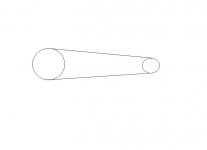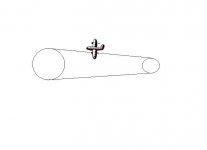maxro said:What's the real-world application? There is no such thing as 'no friction whatsoever'. Beware, this could turn into another conveyer-belt thread.
Max
nah , SV allready answered the question
but , i forgot
There has to be a force on the chain. If there was no force, the momentum of the links that are going straight would keep them going straight. But as you illustrated, they go around the sprockets. The centripetal acceleration of the links makes chain want to come off the sprocket as it goes around. The chain, being a loop, prevents this because the other side of the chain going around the other sprocket wants to come off in the opposite direction. All this results in tension in the chain.
If the chain was a perfect circle, then there would be no force on it.
If the chain was a perfect circle, then there would be no force on it.
quasi said:But even if the chain was a perfect circle wouldn't there be an amount of centrifical force on each chain link as it moved around?
You're right. Either way, there would be tension in the chain. I don't know how I missed that part.
if the chain got no weight to it then there will be no tension if the wheels are spinning at constant speedxplod1236 said:
You're right. Either way, there would be tension in the chain. I don't know how I missed that part.
Relative to what?
Is the chain moving?
Imagine an observer travelling around a stationary sprocket / chain system. To the observer the chain would appear to be moving and there would be forces on the chain relative to the forces on the observers vehicle that would be zero relative to the chain.....
Here we go....
Is the chain moving?
Imagine an observer travelling around a stationary sprocket / chain system. To the observer the chain would appear to be moving and there would be forces on the chain relative to the forces on the observers vehicle that would be zero relative to the chain.....
Here we go....
Guys,
Instead of a chain, picture a rail road track of the same shape. Fill the track ALMOST entirely with cars, frictionless of course, in an airless world, with an inch or two between them.
Now set all the cars in motion... exactly the same speed... yada... yada... yada. Any tension in chain?
When you say "tension in the chain"... where exactly in the chain are you talking about?
There is no net work being done... that doesn't mean there isn't tension somewhere.
Instead of a chain, picture a rail road track of the same shape. Fill the track ALMOST entirely with cars, frictionless of course, in an airless world, with an inch or two between them.
Now set all the cars in motion... exactly the same speed... yada... yada... yada. Any tension in chain?
When you say "tension in the chain"... where exactly in the chain are you talking about?
There is no net work being done... that doesn't mean there isn't tension somewhere.
If you replace the chain with a railroad track and put cars on it, and then set the cars in motion (I'm assuming the cars are following the track), then the cars will fly off the track as the track starts to curve around the sprocket. You never said to set the track in motion too, so I assumed that was stationary. 
Now let's say that you mount the cars to the track, and set the whole thing in motion, then the cars will want to pull the track (chain) off the sprockets due to centripetal acceleration. The track (chain) is designed to not come apart, therefore, the cars will produce tension in the track (chain). The straight parts of the chain, connecting both sprockets, will have tension in them too, because the two parts of the chain, around the sprockets, are trying to separate from each other.
Now let's say that you mount the cars to the track, and set the whole thing in motion, then the cars will want to pull the track (chain) off the sprockets due to centripetal acceleration. The track (chain) is designed to not come apart, therefore, the cars will produce tension in the track (chain). The straight parts of the chain, connecting both sprockets, will have tension in them too, because the two parts of the chain, around the sprockets, are trying to separate from each other.
Instead of a chain, picture a rail road track of the same shape
You got me. I thought you said replace the chain with the railroad track.
If the chain were massless, then there would be no tension. There would be no momentum to keep the links moving in a straight line and it would take 0 force to rotate the links as they move around the sprockets.
- Status
- This old topic is closed. If you want to reopen this topic, contact a moderator using the "Report Post" button.
- Home
- Member Areas
- The Lounge
- Question on physics :)


